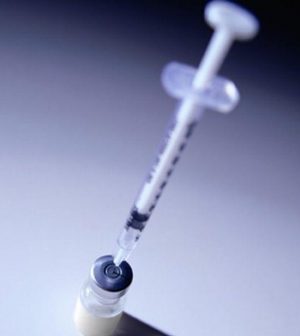- Skip Storing This Everyday Product in the Fridge Door
- Green Tea + B3 Pairing May Boost Brain Health
- Navigating Your Midlife Crisis: Embracing New Possibilities
- City Raccoons Showing Signs of Domestication
- Mapping the Exposome: Science Broadens Focus to Environmental Disease Triggers
- One Week Less on Social Media Linked to Better Mental Health
- Your Brain Changes in Stages as You Age, Study Finds
- Some Suicide Victims Show No Typical Warning Signs, Study Finds
- ByHeart Formula Faces Lawsuits After Babies Sickened With Botulism
- Switch to Vegan Diet Could Cut Your Greenhouse Gas Emissions in Half
Latest COVID Vaccine Shields Against Current Dominant Strain

In some good news for those folks who rolled up their sleeves for the latest COVID vaccine last fall, new government research shows the updated shots halve the chances of getting a symptomatic infection.
“Everything from this study is reassuring that the vaccines are providing the protection that we expected,” study author Ruth Link-Gelles, head of the vaccine effectiveness program for COVID and RSV at the U.S. Centers for Disease Control and Prevention, told CNN. “While we don’t have an estimate of vaccine effectiveness specific to immunocompromised people, the fact that the vaccine is working in the general population provides, I think, reassurance for the whole population.”
Last summer, vaccine makers updated their shots to target the Omicron variant XBB.1.5, which dominated during much of 2023. Luckily, the new CDC data shows these vaccines work just as well against JN.1, the variant that has been fueling most COVID infections in the United States since late December.
For the CDC analysis, researchers analyzed trends among more than 9,000 adults who were tested for COVID at Walgreens and CVS pharmacies between mid-September and mid-January. For some people with positive results, the researchers were able to test for a “quirk” in the virus that lets them differentiate between variants.
Overall, the updated vaccines provided 54% protection against symptomatic infection among healthy adults who were recently vaccinated compared with those who did not get the latest shot, according to the report published Thursday in the CDC publication Morbidity and Mortality Weekly Report.
U.S. vaccination programs primarily aim to prevent severe disease, but measuring how well a shot guards against symptomatic infection gives an early sign of how well vaccines are working.
“That’s a really nice feature of this analysis, that it checks that box: Yes, the vaccine is working, it’s providing protection, it’s providing protection for JN.1, which is the current most common variant,” Link-Gelles said.
The latest COVID shots have only been available since September, so this analysis could only track effectiveness through about four months post-vaccination.
It’s expected that protection from the latest vaccine will wane over time. A very slight “hint” of that was seen in the new study, Link-Gelles acknowledged.
While the United States no longer tracks COVID cases, wastewater data suggests the virus continues to circulate at high levels and there are still plenty of COVID hospitalizations and deaths reported each week.
During the week ending Jan. 20, there were 26,607 COVID hospitalizations and 936 deaths, CDC data shows. Still, only about 22% of adults and 11% of children have gotten the latest COVID shot, the CDC estimates.
Conversely, nearly half of adults and children have gotten the flu vaccine this season. And a flu season where the vaccine matches the circulating strain with 50% effectiveness would be considered a good match, Link-Gelles noted.
“There’s never a bad time to get a COVID vaccine,” she said. “Even with relatively low levels of hospitalization right now… that extra protection is going to go a long way.”
More information
Visit the U.S. Centers for Disease Control and Prevention for more on COVID.
SOURCE: Morbidity and Mortality Weekly Report, Feb. 2, 2024; CNN
Source: HealthDay
Copyright © 2025 HealthDay. All rights reserved.










